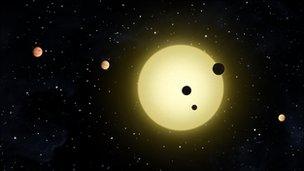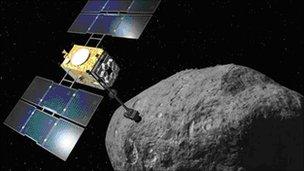European space concepts enter competition
- Published

Telescopes such as Nasa's Kepler observatory are finding huge numbers of exoplanets
The European Space Agency (Esa) has selected four new mission concepts to compete for a launch opportunity at the start of the 2020s.
The mission ideas cover a broad range of disciplines, from investigations of black holes and general relativity to a near-Earth asteroid sample-return and studies of planets orbiting far-away stars.
The concepts have rather impenetrable names right now - Loft, STE-Quest, MarcoPolo-R, and Echo - but that will change for the one eventually selected.
"Originally we had 47 proposals," said Fabio Favata, head of Esa's Science Planning and Community Coordination Office.
"Our working groups and the Space Science Advisory Committee did a great job in trimming the list when they had quite a number of missions that could all potentially make good candidates," he told BBC News.
The mission concepts are put together by research teams whose members drawn from across Europe:
Large Observatory For X-ray Timing (Loft), external: The mission would go after the fast-moving, high-energy environments that surround black holes, neutron stars and pulsars - objects that can produce sudden and very rapid bursts of X-rays. By observing this emission, scientists would hope to address questions related to fundamental physics: they could probe the effects of matter entering ultra-strong gravitational fields and ultra-dense states. They could also measure more accurately the mass and spin of black holes; and in the case of the biggest such objects in the Universe, this has something interesting to say about how they, and the galaxies that host them, formed.
Space-Time Explorer and Quantum Equivalence Principle Space Test (STE-Quest), external: Again, this mission would address some big physics topics. One objective would be to test "the equivalence principle", which underpins several fundamental assumptions including the idea that gravity will accelerate all objects in a vacuum equally regardless of their masses or the materials from which they are made. The Apollo 15 astronaut Dave Scott famously demonstrated this principle when he dropped a hammer and feather on the Moon in 1971 and both hit the surface at the same time. STE-Quest would put very sensitive instrumentation on an orbiting satellite to do a far more precise test of whether gravity really is so blind or perhaps varies on some scales.

MarcoPolo-R comes out of a previous submission to an Esa science mission competition
MarcoPolo-R, external: This is an idea that has been around for a while. The mission would attempt to return a sample of material from an asteroid for detailed analysis in Earth laboratories. The most primitive asteroids contain geochemistry not observable in Earth rocks because they are constantly recycled. As such, asteroids can tell scientists a lot about conditions in the early Solar System, and about the original "stuff" that went into making the planets billions of years ago. One potential target is actually two asteroids in close proximity - a binary known as (175706) 1996FG3. The larger rock is about 1.5km across; its companion is less than half a km in diameter.
Exoplanet Characterisation Observatory (Echo), external: This is a 1.2m telescope that would study planets circling far-away stars. In recent years, hundreds of these so-called exoplanets have been detected, but we know precious little about them yet. Echo would observe the planets as they moved in front of their stars. From the way the light is attenuated, the telescope's detectors would be able to probe the atmospheres of these worlds. Echo would look for the presence of molecules such as ozone and carbon dioxide in the atmospheres. These and other markers might tell us something about whether any of the exoplanets have conditions capable of supporting life.
It takes a long time to plan and then implement a mission. The science has to be compelling and the engineering requirements must be realistic. The feasibility of implementing this quartet will now be thoroughly investigated before a "winner" is chosen. It could take up to four years for a final decision to be made.
Esa is running the competition under its Cosmic Vision programme, and has about 470 million euros (at 2010 prices) to spend on what it terms a Medium Class science mission. The member states would individually cover the cost of building any instruments that go on the spacecraft.
This new opportunity is known as M3; the reason being that there is already a competition in play for an M1 and an M2 spacecraft, with the first of these likely to launch in 2017.
Esa has a Large Class of much more expensive ventures, as well. This competition is in the final stages of selection with a launch opportunity proposed for 2020. If the winner of this competition is delayed for any reason and cannot make the 2020 slot, Esa would like the M3 proposal to be ready to take its place on the launch pad.
- Published21 July 2010